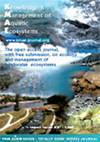不同除草方式对低地溪流物理和水文形态条件的影响
IF 1.7
3区 环境科学与生态学
Q3 FISHERIES
引用次数: 8
摘要
气候变化增加了河流洪水事件的频率和强度。作为回应,管理当局可能会增加水生植物清除(除草)的频率和强度,以降低河流的水位,这可能会损害河流的物理和水文形态条件。我们研究了32条丹麦低地溪流,它们经历了三种不同的杂草修剪方法,代表了杂草修剪强度的梯度,以及未修剪的对照,以比较溪流群之间的物理和水文形态栖息地质量参数。此外,我们还测量了两种河流中溶解氧(DO)浓度和悬浮泥沙(SS)运移的短期变化,分别是在除草之前、期间和之后,对最少量和最普遍的除草方法进行了测量。我们的研究结果表明,随着除草强度的增加,栖息地质量下降,特别是与以牺牲硬基质为代价的淤泥覆盖有关。DO浓度相对没有变化,但在最普遍的方法中,在切割期间观察到与风暴事件相当的SS输送突然增加。我们的研究结果表明,在大规模实施高强度除草之前,应仔细研究和考虑其生态和水文形态学效应。本文章由计算机程序翻译,如有差异,请以英文原文为准。
Effects of different weed cutting methods on physical and hydromorphological conditions in lowland streams
Climate change has increased the frequency and intensity of stream flooding events. In response, managing authorities may increase frequency and intensity of aquatic plant removal (weed cutting) to lower the water level in rivers possibly impairing physical and hydromorphological stream conditions. We studied 32 Danish lowland streams subjected to three different weed cutting practices, representing a gradient in weed cutting intensity, and uncut controls to compare physical and hydromorphological habitat quality parameters among stream groups. Moreover, we measured short-term changes in dissolved oxygen (DO) concentrations and suspended sediment (SS) transport in two streams before, during, and just after weed cutting for the least and most pervasive weed cutting method, respectively. Our results indicated a lower habitat quality affiliated with increasing intensity of weed cutting practice, notably an association with silt cover at the expense of hard substrate. DO concentrations were relatively unaltered but an abrupt increase in SS transport comparable to storm events was observed during cutting with the most pervasive method. Our results indicate that ecological and hydromorphological effects of high intensity weed cutting should be carefully studied and considered before large scale implementation.
求助全文
通过发布文献求助,成功后即可免费获取论文全文。
去求助
来源期刊

Knowledge and Management of Aquatic Ecosystems
环境科学-海洋与淡水生物学
CiteScore
3.70
自引率
5.60%
发文量
22
审稿时长
>12 weeks
期刊介绍:
Knowledge and Management of Aquatic Ecosystems (KMAE-Bulletin Français de la Pêche et de la Pisciculture since 1928) serves as a foundation for scientific advice across the broad spectrum of management and conservation issues related to freshwater ecosystems.
The journal publishes articles, short communications, reviews, comments and replies that contribute to a scientific understanding of freshwater ecosystems and the impact of human activities upon these systems. Its scope includes economic, social, and public administration studies, in so far as they are directly concerned with the management of freshwater ecosystems (e.g. European Water Framework Directive, USA Clean Water Act, Canadian Water Quality Guidelines, …) and prove of general interest to freshwater specialists. Papers on insular freshwater ecosystems and on transitional waters are welcome. KMAE is not a preferred journal for taxonomical, physiological, biological, toxicological studies, unless a clear link to ecological aspects can be established. Articles with a very descriptive content can be accepted if they are part of a broader ecological context.
 求助内容:
求助内容: 应助结果提醒方式:
应助结果提醒方式:


